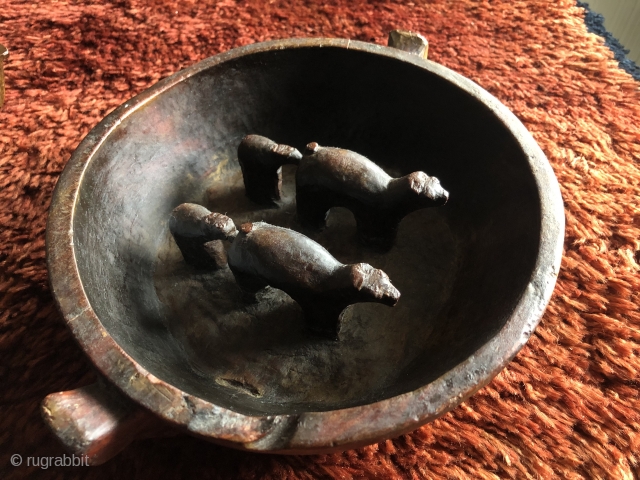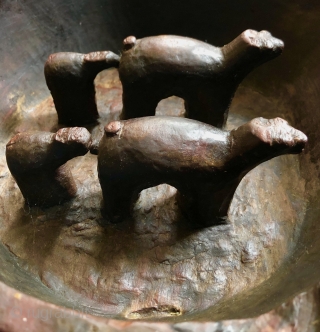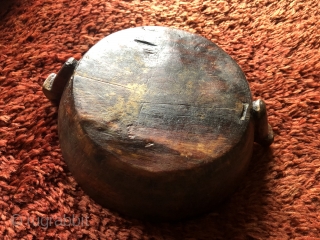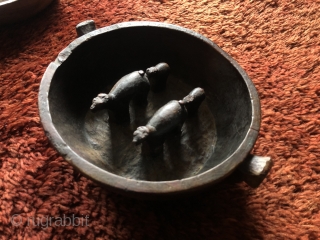Back
This libation vessel depicts two llamas with their nursing young called ‘crias’. The explicit nature of the scene directly ties into the ceremony known as the Animal Increase Rite described by Harry Tschopik in his 1949 book on the Aymara of Chuquito, Peru – Magic. This scene seen here goes to the very heart of this rite. Fecundity is of the utmost importance to pastoralists. Animals equate to wealth and prosperity. This bowl’s imagery is unusual and it is interesting that one of the most important constellations in the ancient Andean sky was called Yacuna – a dark cloud constellation said to depict a mother and daughter llama. The wooden bowl was very heavily encrusted with a sticky tar-like substance indicating extended ceremonial usage over time. Though i have never cleaned these ritual bowls, as i prefer to retain the evidence of ceremonial usage, , but in this case i was forced to remove some of this substance as it was quite sticky and tended to transfer to any surface it came in contact with. There is still some ceremonial material adhering to the bowl, but it is no longer sticky. This is a large, thick and heavy wooden bowl approximately 12 inches in diameter. Over time it had developed two small cracks along the bottom - which were stabilized with native repairs using some kind of thick lead staple-like wrap to stop the cracking. Over time, much of this lead material has deteriorated and only remnants survive today. The the carving of the animals is very much like the miniature stone fetishes called illas that the Kallawaya medicine men carve from alabaster. (Some of these can be seen in other of my postings.) Illas are considered to posses a powerful life force that can bring good fortune when properly cared for and celebrated in ritual circumstances. The figures within these libation bowls are said to be illas in this context. These vessels are also reportedly used in wedding ceremonies for the bride and groom to drink alcoholic beverages from. Animals carved in the center of the bowls represent fertility and prosperity. All of these bowls have handles carved on two sides to facilitate holding them when drinking.
price:
Inquire
- Home
- Antique Rugs by Region
- Category
- Profiles
- Post Items Free
- Albums
- Benaki Museum of Islamic Art
- Budapest: Ottoman Carpets
- Gulbenkian Museum
- Islamic Carpets. Brooklyn
- Islamic Textiles. Brooklyn
- Konya Museum: Rugs
- MKG, Hamburg
- MMA: Caucasian Carpets
- MMA: Mamluk Carpets
- MMA: Mughal Indian Carpets
- MMA: Ottoman Carpets
- MMA: Safavid Persian Carpets
- MMA: Turkmen Rugs
- McCoy Jones Kilims
- Ottoman textiles. Met
- Philadelphia Museum
- Rugs and Carpets: Berlin
- Seljuqs at the Met
- TIEM, Istanbul: Carpets
- V&A: Classical Carpets
- Vakiflar Carpets: Istanbul
- Baluch Rugs: Indianapolis
- Gallery Exhibitions
- Jaf an Exhibition
- Alberto Levi Gallery
- Andean Textile
- Christie's London: 2016
- Francesca Galloway
- HALI at 40
- ICOC Washington, DC 2018
- Jajims of the Shahsavan
- London Islamic Week April, 2018
- Mongolian Felts
- Navajo Rugs: JB Moore
- Persian Piled Weavings
- SF Tribal & Textile Art Show 2020
- SF Tribal 2019
- Sotheby's: C. Alexander
- Turkish Prayer Rugs
- Turkmen Main Carpets ICOC 2007












